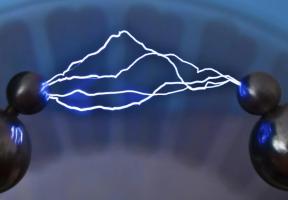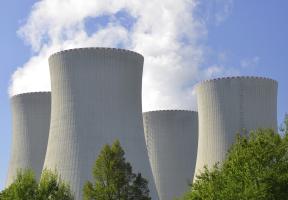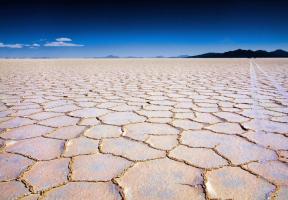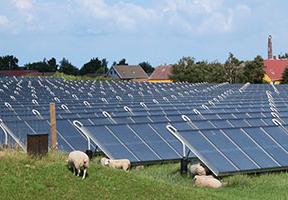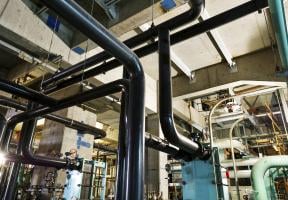Home Heating Equipment
Published on 08.27.20185 min read
On average, heating accounts for 67% of home energy consumption in France and hot water production for 10%, with these proportions varying greatly from household to household.1 Choosing the right heating system is therefore key to increasing and effectively managing energy bills.

© SHUTTERSTOCK - Gas boilers, such as the one shown here, are among the most efficient heating systems, alongside heat pumps and solar panels.
A heating system’s performance depends on the equipment used, but also on the house’s insulation, ventilation and temperature regulation using thermostats.
The efficiency – and therefore the cost – of a heating system is measured by the thermal energy it can generate versus the consumed, expressed as a percentage. The higher this percentage, the greater the system’s energy efficiency.2 Efficiency may be calculated over a full heating season, known as seasonal energy efficiency. For systems using naturally available , efficiency may be greater than 100%.
Any emissions of particulate matter and noxious gases are also taken into account, as well as whether the energy source used is renewable or non-renewable, which has an impact on the amount of greenhouse gases released.
Heating can be provided for the whole house through a central heat source, or decentralized using independent radiators and stoves. Below is a summary of this equipment.3
1. Central Heating Systems
Central heating systems heat water which is then distributed to heat emitters such as radiators or underfloor heating. More rarely, hot air circulation systems may be used. The heat production system may consist of boilers, heat pumps or solar thermal panels.
Oil-fired boilers
Heat is produced through the combustion of domestic oil, which is stored in a tank. This makes oil-fired boilers suitable for individual homes, especially in rural areas that are not connected to the public gas network. In newer boilers, some of the heat from the flue gas is recovered through condensation, which improves efficiency by 15% to 20% compared with conventional models. The condensation produces a liquid which is discharged with wastewater. This type of boiler also helps reduce the release of certain gases: it can decrease emissions of carbon dioxide (CO2) by 30%, sulfur dioxide by 53% and nitrogen oxide by 80%.
Gas condensing boilers
Gas boilers are easy to install and can be supplied with cost-effective gas from the public network, which is cheaper than fuel oil. Newer boilers also integrate a condensing system, with the same advantages as those for oil-fired boilers. Their seasonal efficiency can reach more than 90%. And while they are 30% more expensive to purchase than conventional boilers, they consume 15% to 20% less energy and may qualify for tax incentives.
Low-temperature gas boilers
These boilers send water that is not as hot as the water from conventional models (50°C versus 90°C, in general) through the central heating system. They use less gas when combined with low-temperature underfloor heating systems or radiators, which tend to be larger than conventional radiators. If the emitters are not suitable, the boiler will run for longer and consume more gas.
Micro combined heat and (micro CHP) boilers
Some gas boilers can be used to produce at the same time as heat. This is known as combined heat and power (CHP). The electricity is either consumed on-site or sold to the public grid. Not widely used in France, this equipment is mainly marketed in countries where the cost of electricity is high. Japan is developing stationary fuel cells that generate heat and electricity using produced on-site from liquefied natural gas.
Electric boilers
These boilers use electrical resistance to heat water. Some “ionic” models use an electric field between two electrodes to generate heat.Although they cost less to purchase, electric boilers consume a lot of energy unless combined with a temperature-control system comprising efficient thermostats and low-temperature heat emitters. They do not qualify for environmental tax incentives.
Wood-fired boilers
The use of wood for heating is increasing in France. Pellet boilers are the most efficient, but they usually require a separate room, such as a cellar. Some are equipped with automatic systems to turn the boiler on and off and feed pellets into it, eliminating the need to handle bags of pellets. While these boilers can be expensive, wood is the cheapest fuel on the market. Energy efficiency comes to 65% to 90% for log boilers, or 75% to 105% for pellet and wood‑chip boilers.
heat pumps
Using sensors buried in the ground – which can require a fairly big yard – geothermal heat pumps harness the Earth’s heat, which is then distributed through the home via centrally heated radiators, underfloor heating systems or fan coil units. The pumps are generally used alongside a “buffer” tank to store the hot water until it needs to be fed into the heating network. The consistency of the Earth’s heat means that geothermal heat pumps are a reliable way to heat homes and avoid having to use a back-up source. This method is 140% to 190% energy efficient.
Air source heat pumps
These are made up of two units: one outside to absorb heat from the air, and one inside to distribute it through the home. Air-to-air pumps provide heating through fan coil units, while air-to-water pumps are linked to thesnbap;building’s central heating and water system. As this method is affected by fluctuations in outdoor temperature, it usually requires an integrated back-up system, most commonly running on electricity. This brings its seasonal efficiency down to 110% to 130%.
Combined solar systems
This method works in the same way as an individual solar water heater, but is linked with a central home heating system. The energy is recovered outside through solar thermal panels and conducted via a to the hot water tank and, in a combined system, to the central heating network. However, since sunshine is intermittent, these systems need to be used in conjunction with an additional source of heating. Their efficiency is estimated at 90% to 160%.
District and collective heating networks
Apartments can be heated through a collective heating network shared by the whole building, powered by a boiler in the basement. They can also be linked up with a district network, if there is one nearby, which is supplied with heat produced in industrial boilers.
2. Decentralized Heating Systems
Decentralized heating comes mainly in the form of electric heaters and wood stoves. They can heat a whole house, room by room, or be used as an additional source of heating (in bathrooms, for example).
Electric radiators
Easier and initially less expensive to install than a hot water system, electric heating is used in around 31% of homes in France, particularly newer builds. It is not very efficient (38% at best).
Convector radiators, the most common kind, use an electric resistor that heats air through convection4, that is, the movement of warmer air. The disadvantages of these radiators are that they dry out the air and consume a lot of energy. The most recent models are equipped with electronic thermostats to reduce consumption.
More modern solutions opt for radiation over convection.
- Radiant panels heat the surrounding air, distributing the heat more evenly throughout the room. A single panel can heat a 15 to 20-square-meter room.
- Heat accumulators store heat in a refractory material during periods when the price of electricity is low, then slowly release it during peak times.
- Radiant underfloor heating consists of electric cables that heat a thin mat.
- Radiant ceiling heating is made up of a heating film on a thermal insulation panel, underneath the plasterboard.
Another good solution for bathrooms is dual fuel radiators. These use electricity but remain connected to central heating powered by any source. When the central heating is on, they act like radiators. If the boiler is turned off or if a higher temperature is desired, they resort to electricity.
Wood stoves
Wood stoves work like boilers but are smaller and take esthetics into account, which is reflected in their price. It is also important to make sure that the smoke from wood heaters is properly discharged from the home. Wood burning inserts may be installed to replace an old fireplace. Their efficiency rate, around 75%, is far higher than for open fireplaces, which provide 15% efficiency at best.
3. Hot Water Systems
Like boilers, individual water heaters or storage tanks may be powered by gas, electricity or solar energy.
Two other types of equipment have been developed in the heat pump sector. Air source water heaters use energy from the air to warm a heat transfer fluid, which then conducts heat to the water tank. Geothermal water heaters operate according to the same principle, using the Earth’s heat. They are 90% to 160% efficient.
Sources:
- See Close-Up “Fuel Poverty, A Serious Yet Elusive Problem”
- Efficiency ratings provided by the manufacturer are based on laboratory tests and may differ from the product’s performance in real-life conditions. Electricity is not a primary energy and its production entails upstream losses: it is considered that 1 kWh of final electrical energy requires the use of 2.58 kWh of primary energy.
- See in particular the French Environment and Energy Management Agency (ADEME) guide (in French only) and the “Quelle Energie” website (in French only)
- Convection is one of the three forms of heat transfer (alongside conduction and radiation).


